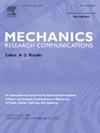弹性分层包体反问题分析的块参数法伴随状态法
IF 2.3
4区 工程技术
Q3 MECHANICS
引用次数: 0
摘要
残差函数梯度的有效计算问题在任何性质的逆问题的分析中都起着重要的作用。计算梯度的方法之一是伴随状态法,它允许将“状态方程”作为正演映射的一部分来考虑。将该方法应用于弹性地基上的层状弹性包的反问题。包层材料一般假定为各向异性和非均匀性,弹性基础参数也是如此。反问题的模型/观测数据是包体上表面某些点的射线位移。利用块参数法对反问题进行分析,得到了无穷维梯度分量的公式。该方法的实质在于对问题的一组参数和模型数据中的先验概率密度和似然函数进行特殊的块参数逼近。该方法可以估计诊断值先验分布的参数,从所创建的模型中识别和排除测量数据的异常值,并以可接受的分辨率构造未知参数的后验概率密度估计。讨论了初始无穷维问题的离散化、基于伴随状态法和不同阶近似的差分格式计算梯度分量的结果的比较,以及多重网格迭代法在求解正演和伴随问题中的应用。本文章由计算机程序翻译,如有差异,请以英文原文为准。
Adjoint state method in the block-parametric approach to the inverse problem analysis for elastic layered packages
Issues of efficiently calculating the gradient of the residual function play an important role in the analysis of inverse problems of any nature. One of the methods for calculating the gradient, which allows considering the “state equation” as part of the forward mapping, is the Adjoint State Method. This method is applied to inverse problems for a layered elastic package located on an elastic foundation. The materials of the package layers are generally assumed to be anisotropic and non-uniform, as are the parameters of the elastic foundation. The model/observed data of the inverse problem are the ray displacements of some points on the upper surface of the package. Formulas for the gradient components are obtained in an infinite-dimensional version using a block-parametric approach to the analysis of inverse problems. The essence of the approach lies in the special block-parametric approximation of the prior probability density and likelihood function in a set of parameters and model data of the problem. The method allows one to estimate the parameters of the prior distribution of the diagnosed values, identify and exclude outliers of measured data from the created model, and construct the estimate of the posterior probability density of unknown parameters with an acceptable resolution. The issues related to the discretization of the initial infinite-dimensional problems, comparison of the results obtained based on the adjoint state method and difference schemes of different orders of approximation for calculating the gradient components, as well as the application of the Multigrid Iterative Method for solving the forward and adjoint problems are considered.
求助全文
通过发布文献求助,成功后即可免费获取论文全文。
去求助
来源期刊
CiteScore
4.10
自引率
4.20%
发文量
114
审稿时长
9 months
期刊介绍:
Mechanics Research Communications publishes, as rapidly as possible, peer-reviewed manuscripts of high standards but restricted length. It aims to provide:
• a fast means of communication
• an exchange of ideas among workers in mechanics
• an effective method of bringing new results quickly to the public
• an informal vehicle for the discussion
• of ideas that may still be in the formative stages
The field of Mechanics will be understood to encompass the behavior of continua, fluids, solids, particles and their mixtures. Submissions must contain a strong, novel contribution to the field of mechanics, and ideally should be focused on current issues in the field involving theoretical, experimental and/or applied research, preferably within the broad expertise encompassed by the Board of Associate Editors. Deviations from these areas should be discussed in advance with the Editor-in-Chief.

 求助内容:
求助内容: 应助结果提醒方式:
应助结果提醒方式:


